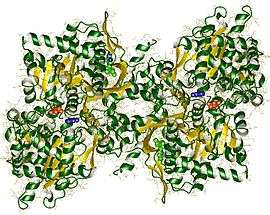Phosphorylase
Phosphorylases are enzymes that catalyze the addition of a phosphate group from an inorganic phosphate (phosphate+hydrogen) to an acceptor.
- A-B + P ⇌ A + P-B
| Phosphorylase | |||||||||
|---|---|---|---|---|---|---|---|---|---|
 | |||||||||
| Identifiers | |||||||||
| EC number | 2.4.1.1 | ||||||||
| CAS number | 9035-74-9 | ||||||||
| Databases | |||||||||
| IntEnz | IntEnz view | ||||||||
| BRENDA | BRENDA entry | ||||||||
| ExPASy | NiceZyme view | ||||||||
| KEGG | KEGG entry | ||||||||
| MetaCyc | metabolic pathway | ||||||||
| PRIAM | profile | ||||||||
| PDB structures | RCSB PDB PDBe PDBsum | ||||||||
| |||||||||
They include allosteric enzymes that catalyze the production of glucose-1-phosphate from a glucan such as glycogen, starch or maltodextrin. Phosphorylase is also a common name used for glycogen phosphorylase in honor of Earl W. Sutherland Jr. who in the late 1930s discovered the first phosphorylase.[1]
Function
Phosphorylases should not be confused with phosphatases, which remove phosphate groups. In more general terms, phosphorylases are enzymes that catalyze the addition of a phosphate group from an inorganic phosphate (phosphate + hydrogen) to an acceptor, not to be confused with a phosphatase (a hydrolase) or a kinase (a phosphotransferase). A phosphatase removes a phosphate group from a donor using water, whereas a kinase transfers a phosphate group from a donor (usually ATP) to an acceptor.
| Enzyme name | Enzymes class | Reaction | Notes |
|---|---|---|---|
| Phosphorylase | Transferase (EC 2.4 and EC 2.7.7) |
A-B + H-OP ⇌ A-OP + H-B | transfer group = A = glycosyl- group or nucleotidyl- group |
| Phosphatase | Hydrolase (EC 3) |
P-B + H-OH ⇌ P-OH + H-B | |
| Kinase | Transferase (EC 2.7.1-2.7.4) |
P-B + H-A ⇌ P-A + H-B | transfer group = P |
| P = phosphonate group, OP = phosphate group, H-OP or P-OH = inorganic phosphate | |||
Types
The phosphorylases fall into the following categories:
- Glycosyltransferases (EC 2.4)
- Enzymes that break down glucans by removing a glucose residue (break O-glycosidic bond)
- glycogen phosphorylase
- starch phosphorylase
- maltodextrin phosphorylase
- Enzymes that break down nucleosides into their constituent bases and sugars (break N-glycosidic bond)
- Purine nucleoside phosphorylase (PNPase)
- Enzymes that break down glucans by removing a glucose residue (break O-glycosidic bond)
- Nucleotidyltransferases (EC 2.7.7)
- Enzymes that have phosphorolytic 3' to 5' exoribonuclease activity (break phosphodiester bond)
- RNase PH
- Polynucleotide Phosphorylase (PNPase)
- Enzymes that have phosphorolytic 3' to 5' exoribonuclease activity (break phosphodiester bond)
All known phosphorylases share catalytic and structural properties .
Activation
Phosphorylase a is the more active R form of glycogen phosphorylase that is derived from the phosphorylation of the less active R form, phosphorylase b with associated AMP. The inactive T form is either phosphorylated by phosphoylase kinase and inhibited by glucose, or dephosphorylated by phosphoprotein phosphatase with inhibition by ATP and/or glucose 6-phosphate. Phosphorylation requires ATP but dephosphorylation releases free inorganic phosphate ions.
Pathology
Some disorders are related to phosphorylases:
- Glycogen storage disease type V - muscle glycogen
- Glycogen storage disease type VI - liver glycogen
See also
References
- Lehninger Principles of Biochemistry 5th ed. pg. 603
External links
- Muscle phosphorylase deficiency - McArdle's Disease Website
- Phosphorylases at the US National Library of Medicine Medical Subject Headings (MeSH)